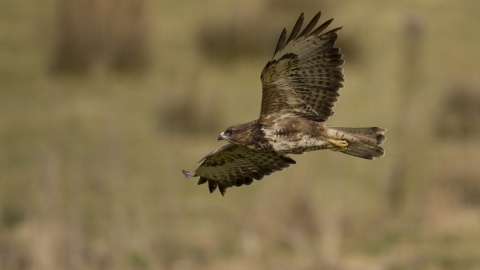Know before you go
Dogs
Visit the 'Dog walking on reserves' page in the Content section for more information.
When to visit
Opening times
Open at all timesBest time to visit
Spring and summer.About the reserve
Lynchcombe reserve and its neighbour SWT Cooks Fields reserve lie on the Mendip escarpment above the village of Westbury sub Mendip. The northern slopes of the reserve are dominated by the strip lynchets associated with the ruined medieval farm site at Deer Leap. Lynchcombe is an important site for its flower-rich grasslands and the areas of semi-natural woodland within the combe.
Where soils are thin, particularly along rocky outcrops, the limestone vegetation is very rich. Common Rock-Rose, Mouse-Ear Hawkweed, Salad Burnet and Wild Thyme occur frequently. Scarcer plants here include Fairy Flax the uncommon Greater Knapweed, Squinancy-Wort, Small Scabious, Large Wild Thyme and Horseshoe Vetch. Typical grasses of the limestone flora include Crested Hair-Grass and Upright Brome. This is a great place for butterflies in the summer; Ringlets and Meadow Browns can be very abundant but also look out for the black and white Marbled White, Common Blue, Small Copper and Small Heath. Around edges of the woodland and scrub you are likely to see the Gatekeeper and Speckled Wood. Dark Green Fritillary and Silver-Washed Fritillary butterflies have also been recorded. Grasshoppers and crickets are plentiful and Great Green Bush-Cricket, Dark Bush-Cricket, Meadow Grasshopper and the Rufous Grasshopper occur. On warm sunny days their combined buzzing can be almost deafening!
The reserve attracts summer visiting birds including Whitethroats and the occasional Grasshopper Warbler both of which favour the scrubbier areas of the reserve. Green Woodpecker and Great Spotted Woodpecker are around all year as are Ravens and Skylark. Kestrels and Buzzard regularly hunt over the site.
Reserve conservation management - The reserve is managed primarily by grazing with sheep and occasionally cattle during the spring and summer, which keeps the vegetation low to allow flowering plants to flourish. Large areas of scrub are being cleared to restore the grassland, as well as to prevent damage to the lynchets. Some scrub areas are being retained and cut on a rotation. Bracken is also being controlled to prevent it dominating the grassland.
History and archaeology - The slopes of the valley, especially on the northern side, are dominated by the medieval strip lynchets associated with the farm site lying on the flatter, higher ground on Deer Leap Reserve. The farm is thought to have been occupied from the late 10th century (Saxon) to about 1670. These areas have been designated as a Scheduled Monument. A small stream disappears underground into the permeable carboniferous limestone at Ramspit Swallet before re-emerging about 1km further down the hill.
Extra information - Marshy areas around the stream running into Ramspit Swallet contain damp grassland species including Fool’s Watercress, Brooklime and Flote Grass. Thistles, especially Spear Thistle and Nodding Thistle occur frequently here. Also around the swallet is an area of woodland dominated by Ash, Hazel and Hawthorn. The ground flora contains Ground Ivy, Herb-Robert and Enchanter’s Nightshade, Wood Speedwell, Moschatel and Wood Spurge. The shaded rocky exposures here have been colonised by Soft Shield-Fern, Hart’s-Tongue Fern, Brittle Bladder-Fern and Maidenhair Spleenwort.
Scrub, dominated by Hawthorn, Blackthorn and Ash has developed in places, especially on the thicker soil of the lynchets of the Medieval field system and there are a number of larger Ash, including several old pollards as isolated trees within the grassland.
Occupied Badger setts occur within the reserve, and some evidence of Dormice has been found in the woodland/scrub. Rabbits are numerous and Brown Hare also occur. The reserve appears to provide an important and extensive bat foraging habitat. A number of mature standard and pollard trees contain holes that may provide suitable bat roosting sites.

